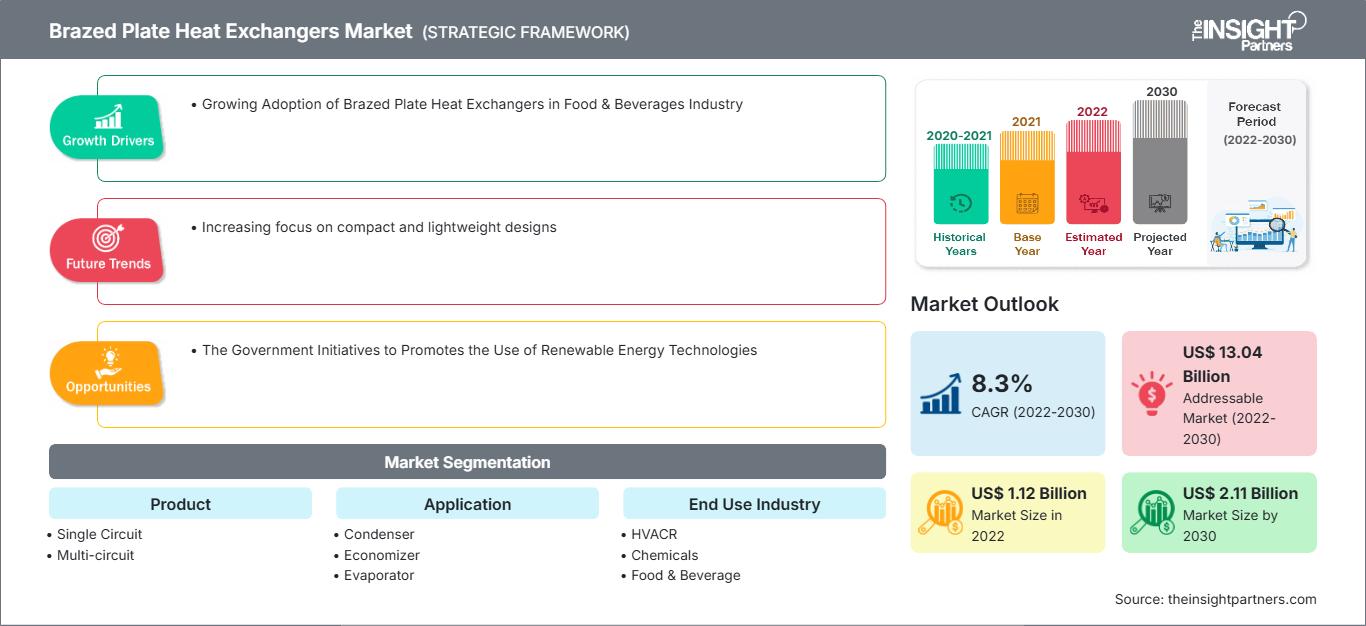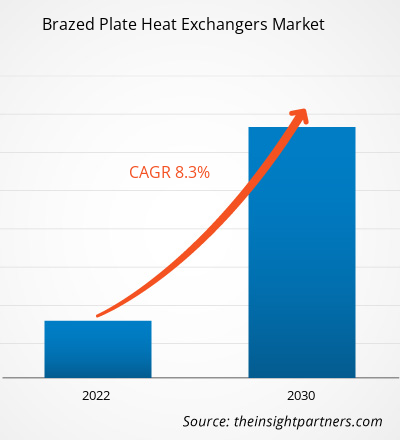2022 年钎焊板式换热器市场规模为 11.2 亿美元,预计到 2030 年将达到 21.1 亿美元;预计 2022 年至 2030 年的复合年增长率为 8.3%。
对紧凑轻量化设计的日益关注可能仍将是市场的主要趋势。钎焊板式换热器市场分析
食品饮料行业、制药行业的不断扩张以及 HVACR 行业对钎焊板式换热器日益增长的使用正在推动市场的发展。由于可再生能源项目数量的不断增加,预计预测期内市场将以显著的速度扩张。此外,政府推动可再生能源技术应用的举措以及各行各业越来越多地采用新技术,为市场创造了丰厚的利润。
钎焊板式换热器市场概览
钎焊板式换热器是一种在加热或冷却系统中执行多种功能的设备,包括冷凝器、蒸发器、油或气体冷却器以及其他热量或冷却传递功能。钎焊板式换热器结构紧凑、高效且免维护,专为任务优化而设计,具有许多独特的特性,可提供更高的热性能和最佳的可靠性。钎焊板式换热器广泛应用于各行各业,尤其是大型住宅热网。它们在提供空调工艺和生产、制冷、数据中心冷却和家庭供暖方面发挥着至关重要的作用。
自定义此报告以满足您的要求
您将免费获得任何报告的定制,包括本报告的部分内容,或国家级分析、Excel 数据包,以及为初创企业和大学提供超值优惠和折扣
钎焊板式换热器市场: 战略洞察

-
获取本报告的主要市场趋势。这个免费样本将包括数据分析,从市场趋势到估计和预测。
钎焊板式换热器 (BPHE) 广泛应用于食品和饮料行业,包括加热、冷却和灭菌。BPHE 通常用于加热和冷却各种液体,例如牛奶、果汁、水和糖浆。它们还用于加热和冷却发酵罐和其他容器。此外,据德国食品饮料工业联合会 (BVE) 报告,截至 2022 年 10 月,德国食品行业收入同比增长 17.3%,从 2021 年到 212 亿美元。德国食品制造商在 2021 年的销售额为 141 亿美元,比 2020 年同期增长 18.5%。因此,不断增长的食品和饮料行业饮料行业推动了该国市场的增长。
政府推动使用可再生能源技术的举措
各国政府都在为使用可再生能源技术提供激励措施。这为钎焊板式换热器创造了机会,这种换热器可以利用地热能、太阳能和其他可再生能源为建筑物供暖和制冷。《加拿大净零排放责任法》规定,联邦政府必须在 2050 年前实现温室气体 (GHG) 净零排放。此外,加拿大承诺根据《加拿大环境保护法》建立清洁能源标准,促进可再生能源的发展,并将各个地区与清洁能源联系起来,以规定到 2035 年所有发电都实现净零排放。为了鼓励对清洁增长和清洁电力的大量投资,2023 年联邦预算为这些领域拨款 7000 万美元。其中包括大幅增加投资税收优惠。因此,随着钎焊板式换热器广泛应用于可再生能源的供暖,人们对可再生能源的日益关注正在推动市场的增长。
钎焊板式换热器市场报告细分分析
钎焊板式换热器市场分析的关键细分市场是产品、应用和最终用途行业。
- 基于产品,钎焊板式换热器市场分为单回路和多回路。多回路细分市场在 2022 年占据了更大的市场份额。
- 就应用而言,市场分为冷凝器、省煤器、蒸发器和其他。蒸发器细分市场在 2022 年占据了更大的市场份额。
- 基于最终用途行业,钎焊板式换热器市场细分为 HVACR、化工、食品和饮料、电力、重工业、IT 和电信等。 2022 年,暖通空调制冷 (HVACR) 领域占据了更大的市场份额。
钎焊板式换热器市场份额按地区分析
钎焊板式换热器市场报告的地理范围主要分为五个区域:北美、亚太地区、欧洲、中东和非洲以及南美和中美。
由于澳大利亚、印度、韩国、中国和日本越来越多地采用钎焊板式换热器来满足工业制冷或供暖需求,预计亚太地区市场在预测期内将扩大。此外,这些国家的制造商正在通过并购扩大其业务范围,为客户提供高质量的制冷系统。例如,2023 年 5 月,江森自控国际有限公司宣布已达成最终协议,收购 Gordon Brothers Industries (GBI),后者是澳大利亚最大的工业制冷 (IR) 解决方案提供商,提供制冷系统设计、建造、服务和零件。此次收购将增强江森自控国际有限公司在澳大利亚的影响力,并使其能够获得各种产品和服务,例如采用低全球变暖潜能值制冷剂的节能设备。GBI 团队将接受培训,负责江森自控为其工业制冷、暖通空调和供暖通风系统提供的设备的设计、工程、选型和定价。因此,此类协议的增多将推动澳大利亚钎焊板式换热器市场的增长。
钎焊板式换热器市场
钎焊板式换热器市场The Insight Partners 的分析师已详尽阐述了预测期内影响钎焊板式换热器市场的区域趋势和因素。本节还讨论了北美、欧洲、亚太地区、中东和非洲以及南美和中美洲的钎焊板式换热器市场细分和地域分布。
钎焊板式换热器市场报告范围
| 报告属性 | 细节 |
|---|---|
| 市场规模 2022 | US$ 1.12 Billion |
| 市场规模 2030 | US$ 2.11 Billion |
| 全球复合年增长率 (2022 - 2030) | 8.3% |
| 历史数据 | 2020-2021 |
| 预测期 | 2022-2030 |
| 涵盖的领域 |
By 产品
|
| 覆盖地区和国家 |
北美
|
| 市场领导者和主要公司简介 |
|
钎焊板式换热器市场参与者密度:了解其对业务动态的影响
钎焊板式换热器市场正在快速增长,这得益于终端用户需求的不断增长,而这些需求的驱动因素包括消费者偏好的不断变化、技术进步以及对产品优势的认知度不断提高。随着需求的增长,企业正在扩展产品线,不断创新以满足消费者需求,并抓住新兴趋势,从而进一步推动市场增长。

- 获取 钎焊板式换热器市场 主要参与者概述
钎焊板式换热器市场评估通过收集一手资料和二手资料后的定性和定量数据进行,这些资料包括重要的企业出版物、协会数据和数据库。钎焊板式换热器市场的一些发展如下:
- SWEP 推出了 B8DW 装置,作为双壁换热器系列的最新成员,专为需要改进泄漏保护的应用而设计。(来源:SWEP International AB,公司网站,2023 年 8 月)。
- 阿法拉伐钎焊和熔焊换热器业务部门宣布,将增加钎焊板式换热器的产量,以满足全球能源转型中日益增长的需求。 (来源:Alfa Laval AB,公司网站,2023 年 5 月)。
钎焊板式换热器市场报告覆盖范围和交付成果
“钎焊板式换热器市场规模和预测(2020 年–2030 年)”报告对以下领域进行了详细的市场分析:
- 钎焊板式换热器市场规模以及涵盖范围内所有关键细分市场的全球、区域和国家/地区预测
- 钎焊板式换热器市场趋势以及市场动态,例如驱动因素、限制因素和关键机遇
- 详细的 PEST/Porter 五力模型和 SWOT 分析
- 钎焊板式换热器市场分析,涵盖关键市场趋势、全球和区域框架、主要参与者、法规和最新市场发展
- 行业格局和竞争分析,涵盖市场集中度、热图分析、知名参与者和钎焊板式换热器市场的最新发展
- 详细的公司简介
- 历史分析(2 年)、基准年、预测(7 年)及复合年增长率
- PEST和SWOT分析
- 市场规模、价值/数量 - 全球、区域、国家
- 行业和竞争格局
- Excel 数据集
近期报告
相关报告
客户评价
购买理由
- 明智的决策
- 了解市场动态
- 竞争分析
- 客户洞察
- 市场预测
- 风险规避
- 战略规划
- 投资论证
- 识别新兴市场
- 优化营销策略
- 提升运营效率
- 顺应监管趋势






















 获取免费样品 - 钎焊板式换热器市场
获取免费样品 - 钎焊板式换热器市场